Abstract
AIMS--To evaluate the influence of involvement of the peritoneal surface by carcinoma of the rectum on local recurrence and prognosis. METHODS--Prospective analysis of pathological prognostic factors in 209 resections for rectal carcinoma between 1988 and 1993 with meticulous pathological technique particularly to assess the relation of tumour to the peritoneal surface. Comprehensive clinical follow up with cause of death established from all available sources of information (hospital and general practitioner data) with necropsies where necessary. Local recurrence was determined by accepted clinical, radiological and pathological criteria. RESULTS--Local peritoneal involvement was detected in 25.8% (54/209) of cases. It was more common in women and was associated with tumour differentiation, size and site, and lymph node involvement. Local peritoneal involvement showed considerable prognostic disadvantage in all cases and in curative cases alone. Multivariate analysis demonstrated independent prognostic disadvantage for all cases although this was lost in the curative group. With a 30 month median follow up time, comprehensive clinical surveillance detected 25 (12.0%) local recurrences. Thirteen (52%) palliative cases had shown spread to involve the mesorectal (deep, circumferential) resection margin. Of the 12 curative cases, six were upper rectal cancers with local peritoneal involvement suggesting that tumour seeding into the pelvic peritoneal cavity was the cause of local recurrence. Local recurrence of the six other rectal tumours was probably because of intraluminal seeding in two, involvement of the distal margin in one, extensive extramural venous involvement in two, and tumour spread to the bladder in one. CONCLUSIONS--Comprehensive pathological analysis of a resection specimen can identify cases with a high probability of local recurrence which may benefit from early adjuvant therapy. Involvement of the peritoneal surface is a common event in rectal cancer, has adverse prognostic influence and may be an important factor in local recurrence of upper rectal carcinoma.
Full text
PDF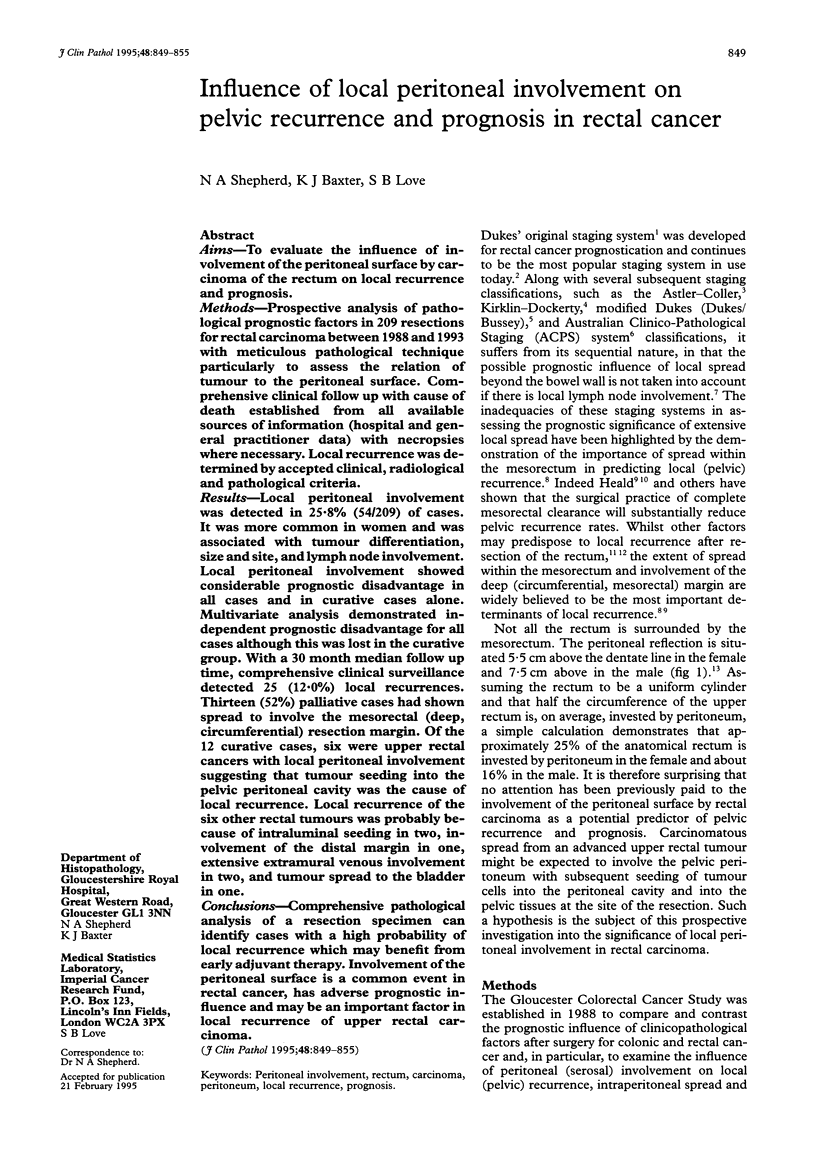
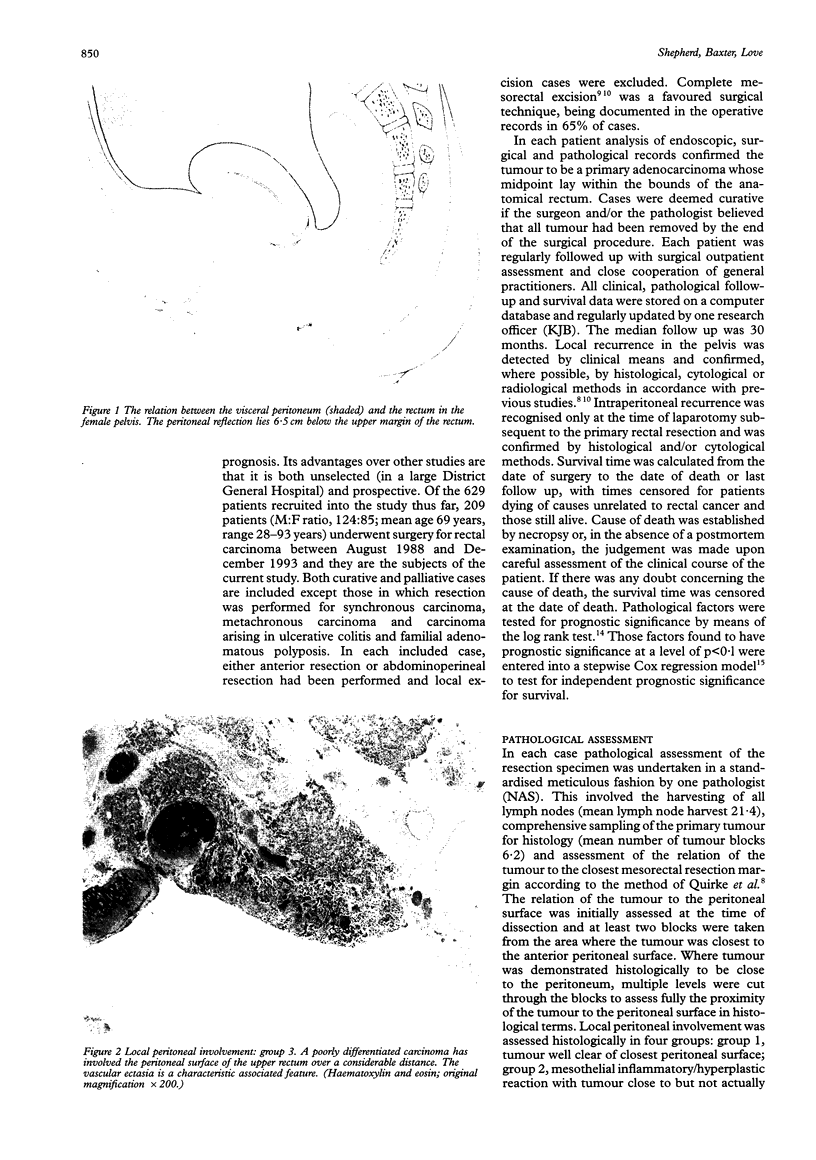
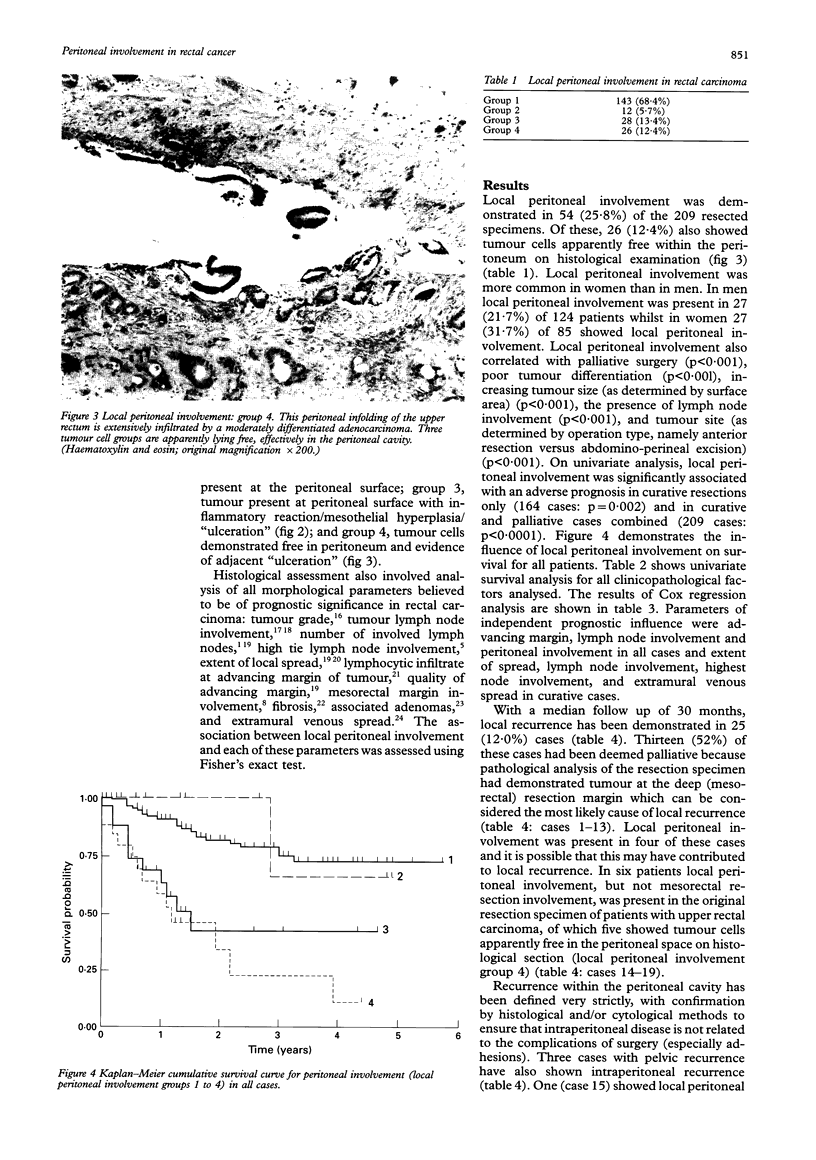
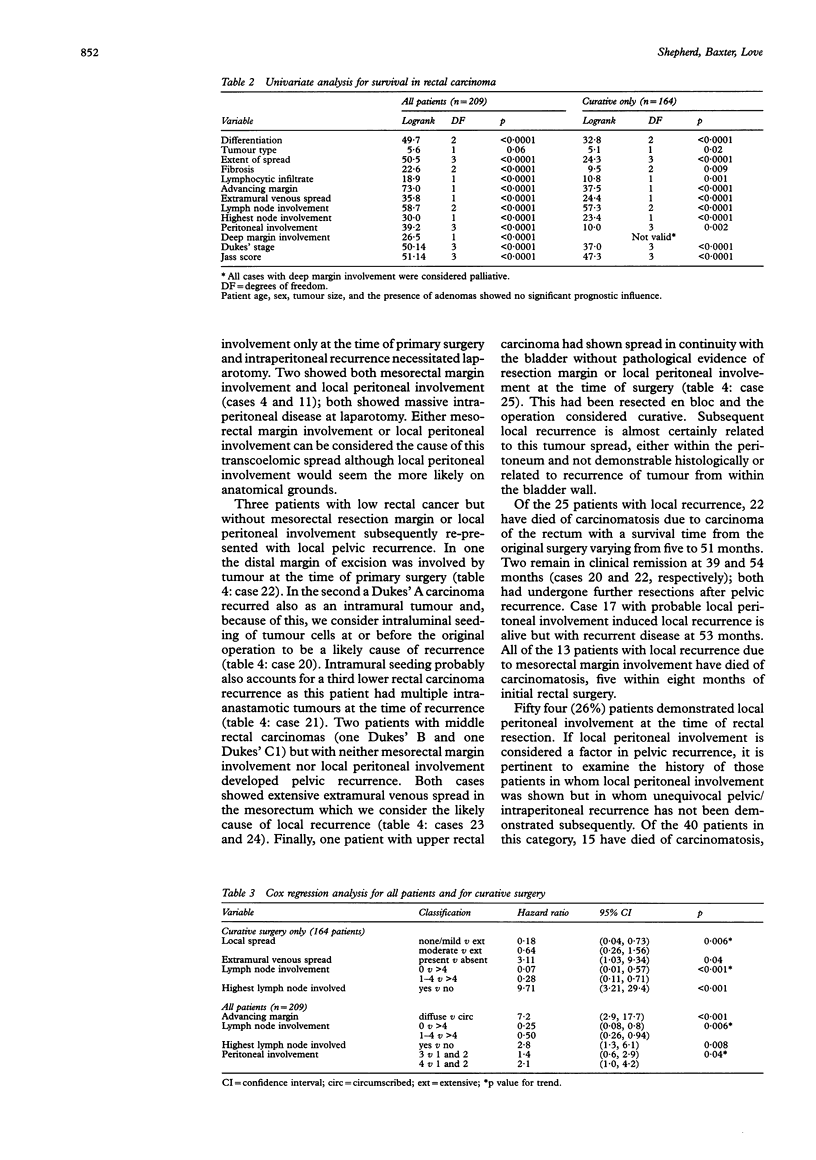
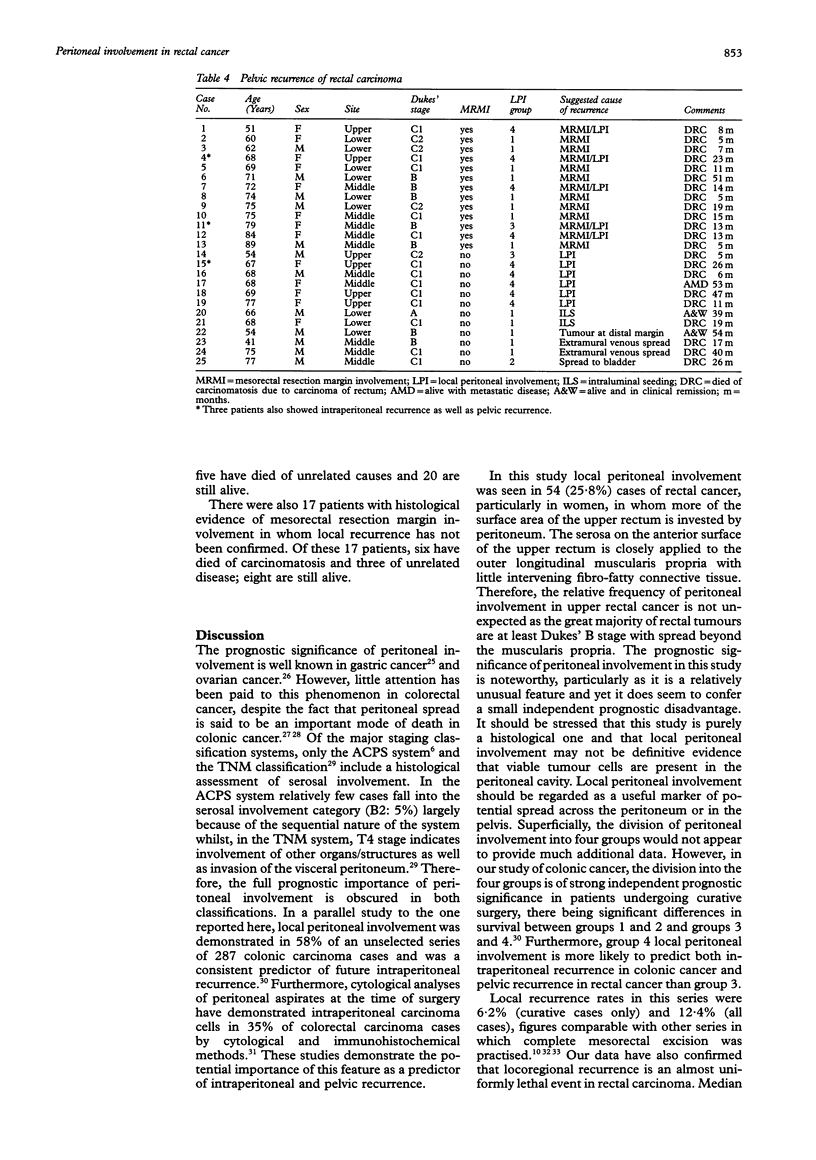
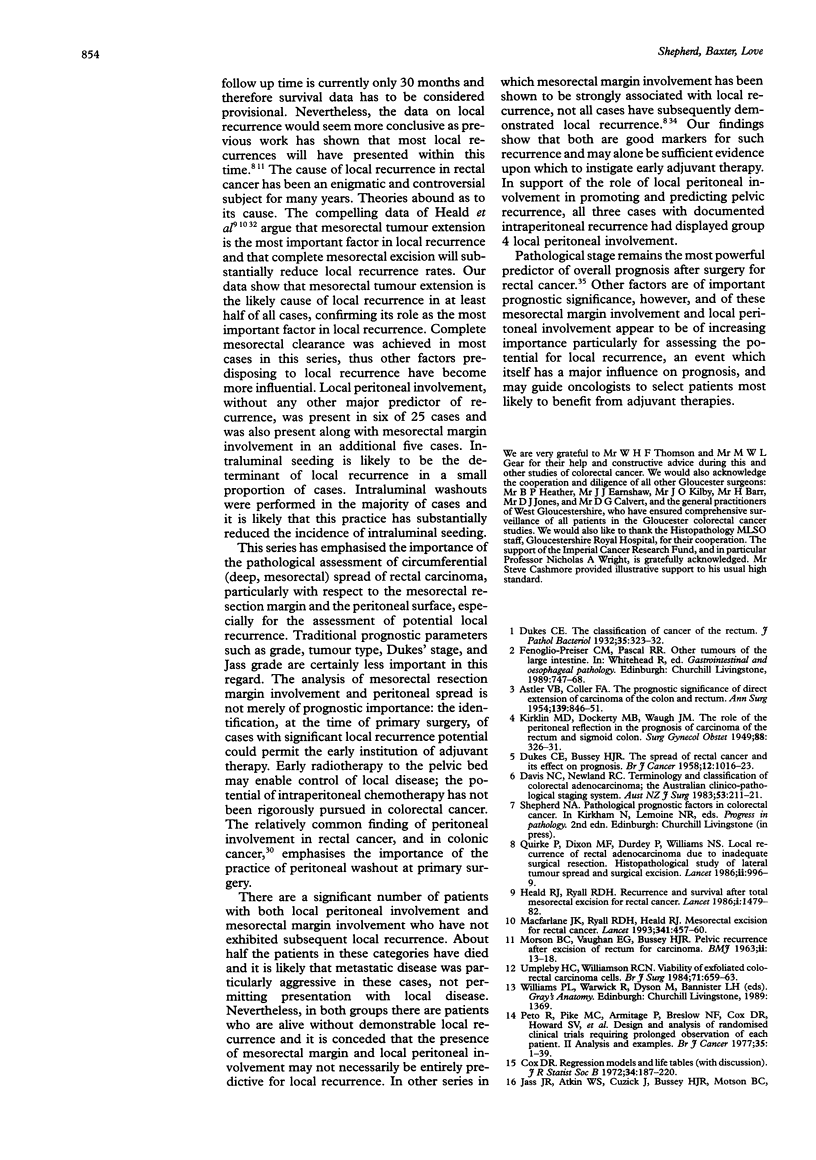
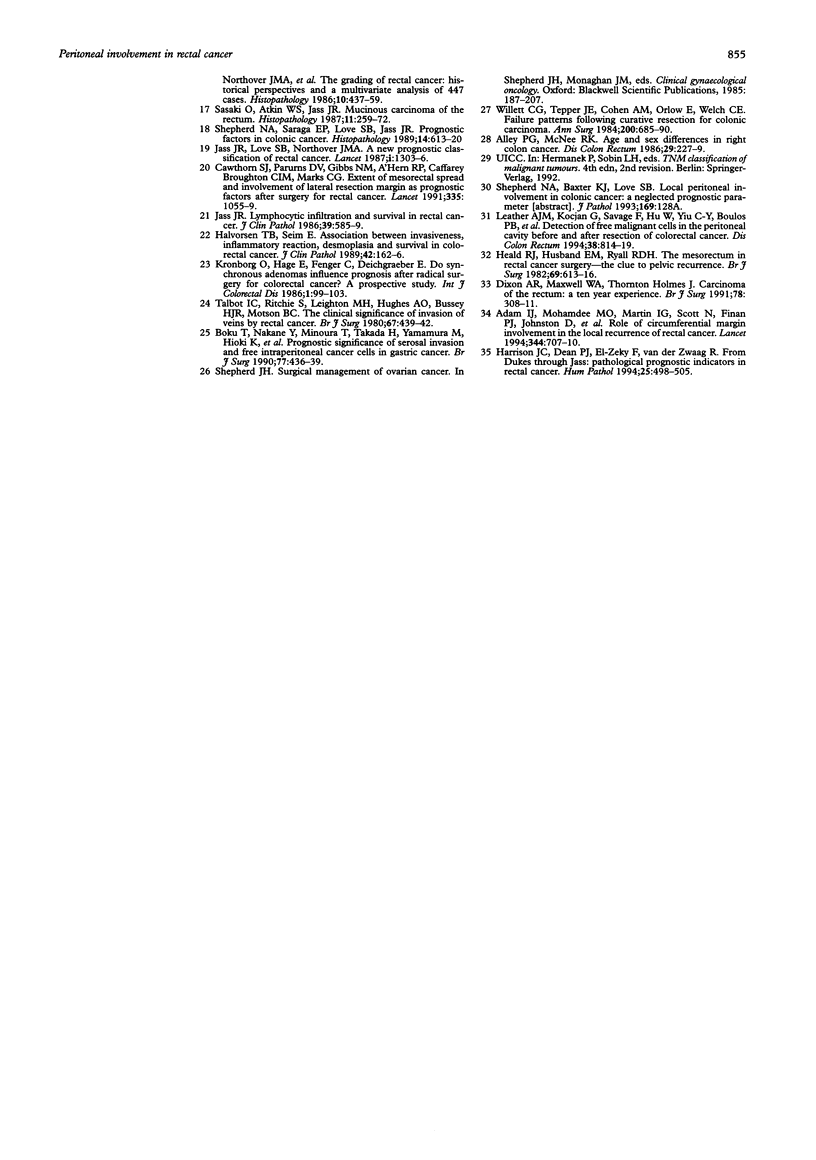
Images in this article
Selected References
These references are in PubMed. This may not be the complete list of references from this article.
- ASTLER V. B., COLLER F. A. The prognostic significance of direct extension of carcinoma of the colon and rectum. Ann Surg. 1954 Jun;139(6):846–852. doi: 10.1097/00000658-195406000-00015. [DOI] [PMC free article] [PubMed] [Google Scholar]
- Adam I. J., Mohamdee M. O., Martin I. G., Scott N., Finan P. J., Johnston D., Dixon M. F., Quirke P. Role of circumferential margin involvement in the local recurrence of rectal cancer. Lancet. 1994 Sep 10;344(8924):707–711. doi: 10.1016/s0140-6736(94)92206-3. [DOI] [PubMed] [Google Scholar]
- Alley P. G., McNee R. K. Age and sex differences in right colon cancer. Dis Colon Rectum. 1986 Apr;29(4):227–229. doi: 10.1007/BF02553021. [DOI] [PubMed] [Google Scholar]
- Boku T., Nakane Y., Minoura T., Takada H., Yamamura M., Hioki K., Yamamoto M. Prognostic significance of serosal invasion and free intraperitoneal cancer cells in gastric cancer. Br J Surg. 1990 Apr;77(4):436–439. doi: 10.1002/bjs.1800770425. [DOI] [PubMed] [Google Scholar]
- Cawthorn S. J., Parums D. V., Gibbs N. M., A'Hern R. P., Caffarey S. M., Broughton C. I., Marks C. G. Extent of mesorectal spread and involvement of lateral resection margin as prognostic factors after surgery for rectal cancer. Lancet. 1990 May 5;335(8697):1055–1059. doi: 10.1016/0140-6736(90)92631-q. [DOI] [PubMed] [Google Scholar]
- Davis N. C., Newland R. C. Terminology and classification of colorectal adenocarcinoma: the Australian clinico-pathological staging system. Aust N Z J Surg. 1983 Jun;53(3):211–221. doi: 10.1111/j.1445-2197.1983.tb02430.x. [DOI] [PubMed] [Google Scholar]
- Dixon A. R., Maxwell W. A., Holmes J. T. Carcinoma of the rectum: a 10-year experience. Br J Surg. 1991 Mar;78(3):308–311. doi: 10.1002/bjs.1800780314. [DOI] [PubMed] [Google Scholar]
- Halvorsen T. B., Seim E. Association between invasiveness, inflammatory reaction, desmoplasia and survival in colorectal cancer. J Clin Pathol. 1989 Feb;42(2):162–166. doi: 10.1136/jcp.42.2.162. [DOI] [PMC free article] [PubMed] [Google Scholar]
- Harrison J. C., Dean P. J., el-Zeky F., Vander Zwaag R. From Dukes through Jass: pathological prognostic indicators in rectal cancer. Hum Pathol. 1994 May;25(5):498–505. doi: 10.1016/0046-8177(94)90122-8. [DOI] [PubMed] [Google Scholar]
- Heald R. J., Husband E. M., Ryall R. D. The mesorectum in rectal cancer surgery--the clue to pelvic recurrence? Br J Surg. 1982 Oct;69(10):613–616. doi: 10.1002/bjs.1800691019. [DOI] [PubMed] [Google Scholar]
- Jass J. R., Atkin W. S., Cuzick J., Bussey H. J., Morson B. C., Northover J. M., Todd I. P. The grading of rectal cancer: historical perspectives and a multivariate analysis of 447 cases. Histopathology. 1986 May;10(5):437–459. doi: 10.1111/j.1365-2559.1986.tb02497.x. [DOI] [PubMed] [Google Scholar]
- Jass J. R., Love S. B., Northover J. M. A new prognostic classification of rectal cancer. Lancet. 1987 Jun 6;1(8545):1303–1306. doi: 10.1016/s0140-6736(87)90552-6. [DOI] [PubMed] [Google Scholar]
- Jass J. R. Lymphocytic infiltration and survival in rectal cancer. J Clin Pathol. 1986 Jun;39(6):585–589. doi: 10.1136/jcp.39.6.585. [DOI] [PMC free article] [PubMed] [Google Scholar]
- Kronborg O., Hage E., Fenger C., Deichgraeber E. Do synchronous adenomas influence prognosis after radical surgery for colorectal carcinoma? A prospective study. Int J Colorectal Dis. 1986 Apr;1(2):99–103. doi: 10.1007/BF01648415. [DOI] [PubMed] [Google Scholar]
- Leather A. J., Kocjan G., Savage F., Hu W., Yiu C. Y., Boulos P. B., Northover J. M., Phillips R. K. Detection of free malignant cells in the peritoneal cavity before and after resection of colorectal cancer. Dis Colon Rectum. 1994 Aug;37(8):814–819. doi: 10.1007/BF02050147. [DOI] [PubMed] [Google Scholar]
- MacFarlane J. K., Ryall R. D., Heald R. J. Mesorectal excision for rectal cancer. Lancet. 1993 Feb 20;341(8843):457–460. doi: 10.1016/0140-6736(93)90207-w. [DOI] [PubMed] [Google Scholar]
- Morson B. C., Vaughan E. G., Bussey H. J. Pelvic Recurrence after Excision of Rectum for Carcinoma. Br Med J. 1963 Jul 6;2(5348):13–18. doi: 10.1136/bmj.2.5348.13. [DOI] [PMC free article] [PubMed] [Google Scholar]
- Peto R., Pike M. C., Armitage P., Breslow N. E., Cox D. R., Howard S. V., Mantel N., McPherson K., Peto J., Smith P. G. Design and analysis of randomized clinical trials requiring prolonged observation of each patient. II. analysis and examples. Br J Cancer. 1977 Jan;35(1):1–39. doi: 10.1038/bjc.1977.1. [DOI] [PMC free article] [PubMed] [Google Scholar]
- Quirke P., Durdey P., Dixon M. F., Williams N. S. Local recurrence of rectal adenocarcinoma due to inadequate surgical resection. Histopathological study of lateral tumour spread and surgical excision. Lancet. 1986 Nov 1;2(8514):996–999. doi: 10.1016/s0140-6736(86)92612-7. [DOI] [PubMed] [Google Scholar]
- Sasaki O., Atkin W. S., Jass J. R. Mucinous carcinoma of the rectum. Histopathology. 1987 Mar;11(3):259–272. doi: 10.1111/j.1365-2559.1987.tb02631.x. [DOI] [PubMed] [Google Scholar]
- Shepherd N. A., Saraga E. P., Love S. B., Jass J. R. Prognostic factors in colonic cancer. Histopathology. 1989 Jun;14(6):613–620. doi: 10.1111/j.1365-2559.1989.tb02202.x. [DOI] [PubMed] [Google Scholar]
- Talbot I. C., Ritchie S., Leighton M. H., Hughes A. O., Bussey H. J., Morson B. C. The clinical significance of invasion of veins by rectal cancer. Br J Surg. 1980 Jun;67(6):439–442. doi: 10.1002/bjs.1800670619. [DOI] [PubMed] [Google Scholar]
- Umpleby H. C., Fermor B., Symes M. O., Williamson R. C. Viability of exfoliated colorectal carcinoma cells. Br J Surg. 1984 Sep;71(9):659–663. doi: 10.1002/bjs.1800710902. [DOI] [PubMed] [Google Scholar]
- Willett C. G., Tepper J. E., Cohen A. M., Orlow E., Welch C. E. Failure patterns following curative resection of colonic carcinoma. Ann Surg. 1984 Dec;200(6):685–690. doi: 10.1097/00000658-198412000-00001. [DOI] [PMC free article] [PubMed] [Google Scholar]





